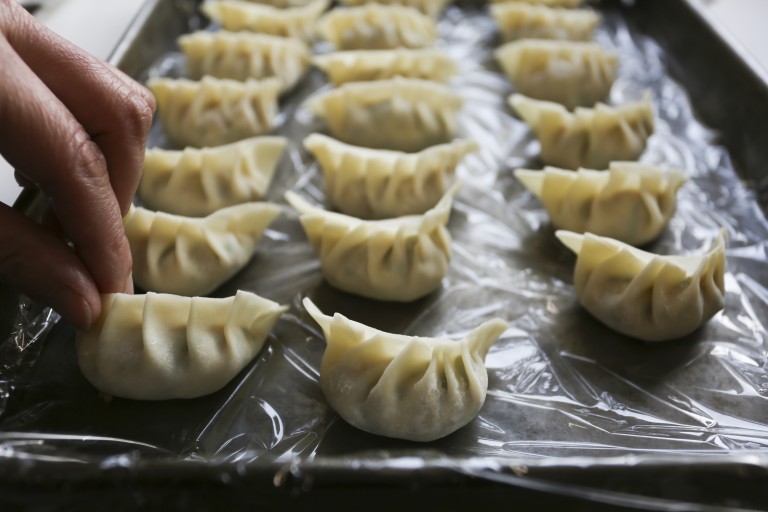
I had a hard time with the filling for these vegan potstickers. Because there’s no minced meat in the filling, something else is needed to bind all the ingredients together. And without meat, the filling was bland. As it turns out, different types of bean curd solve both problems. Regular bean curd doesn’t work as a binding ingredient - even firm bean curd is too watery. Pressed bean curd does work, however, although it needs to be the right type because there are several versions, including some that are pressed so firmly they have hardly any moisture.
Buy regular pressed bean curd, which still has some moisture and is still pliable enough that you can bend it. To add flavour, mix in fermented bean curd (called fu yu) - just two or three cubes of it, because a little goes a long way.
For the cordycep flowers and bamboo pith, you'll need to visit a shop specialising in Chinese ingredients.
Buy thin, round wrappers - the type labelled (depending on where you buy them) for sui gau, wor tip, jiaozi or gyoza. Use Chinese chives, not the European type, which are far too subtle for this dish.
Put the Chinese mushrooms, cordycep flowers and bamboo pith in a colander, rinse them with water then drain. Put them in a bowl, cover with warm water and leave to soak for several hours, or until the mushrooms are completely hydrated, about three hours (or you can do this overnight in the fridge, if it's easier for you). Drain the ingredients and squeeze out as much moisture as possible. (The soaking liquid can be strained and added to vegetarian soup stocks.) Finely chop the mushrooms, cordycep flowers, bamboo pith and Chinese chives and put them in a bowl.
Break the pressed bean curd into large pieces and wrap them in a double layer of paper towels. Squeeze gently to blot up the excess liquid, but not enough so the bean curd is completely dry and crumbly - when you press it together, it should hold its shape. Put the bean curd in the bowl with the mushrooms, cordycep flowers and bamboo pith and add the fermented bean curd, fermented yellow bean sauce, salt, soy sauce, sesame oil, white pepper and cornstarch. Mix the ingredients thoroughly, then taste - add more salt, if needed. Squeeze a spoonful of the mixture together - it should hold its shape; if it's dry and crumbly, add just enough of the soaking liquid so the consistency is right; if it seems too wet, mix in a little more cornstarch.
Line a tray with clingfilm. Pour water into a small bowl.

Take one of the dumpling wrappers and put it in the palm of your non-dominant hand. Place a heaped teaspoonful of the filling on the wrapper - you need enough so it's well-stuffed, but not so much that it oozes out. Use some of the water to very lightly dampen half the wrapper, then fold it over and pleat the edges to make a dumpling that's in a crescent shape, with the edges firmly sealed. Everyone has their own dumpling folding technique, so use yours (although if you don't know how to do it, type in "how to wrap dumplings" in YouTube, and pick your favourite method). Place the dumplings pleated-side up on the tray, pressing on them slightly to flatten the bottom (this is the part that will come in contact with the pan when you cook them).
After folding all the dumplings, heat a skillet (preferably black cast-iron) over a medium-high flame. When the skillet is hot, pour in oil to coat it thoroughly. Add the dumplings (cook them in batches) and pan-fry them until the bottoms are well browned. Pour in about 45ml (3 tbsp) of water (it will splatter furiously) then immediately cover the skillet with the lid and turn the heat to low. Cook the dumplings for about three minutes, adding a little more water if it dries out. Uncover the pan, increase the heat and let the excess water sizzle away, so the bottoms of the dumplings crisp up slightly. Repeat for each batch. Place the dumplings brown side-up on a plate and serve with the sauce ingredients in bowls, so the diners can mix their own.